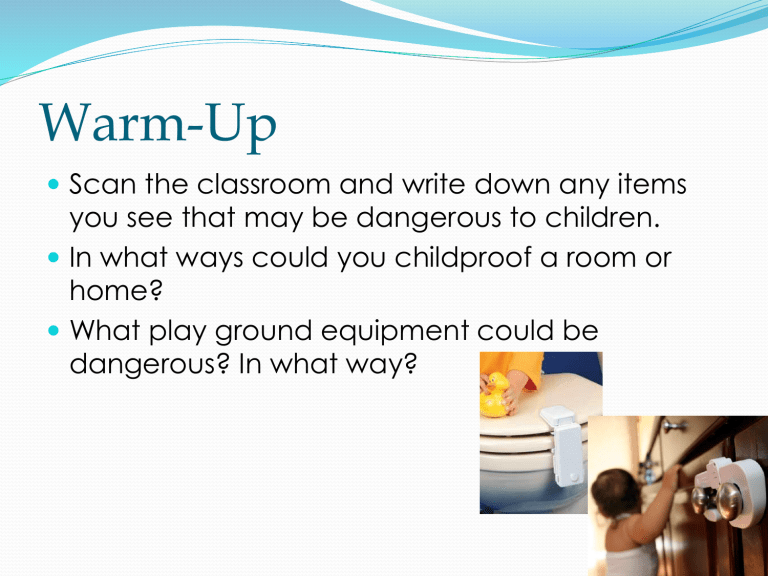
Warm-Up
Scan the classroom and write down any items
you see that may be dangerous to children.
In what ways could you childproof a room or
home?
What play ground equipment could be
dangerous? In what way?
Child Guidance*Kilgore
Child Safety
Dangers can be found everywhere in a child
care center.
Electrical outlets, cleaning supplies, outdoor
climbing equipment, etc.
Accidents are more likely to occur when the
children’s routine is disrupted or when staff is
absent, busy or tired.
Safety Objectives
Supervise children at ALL times.
Maintain the minimum adult-child ratio.
Develop safety limits.
Provide a safe environment.
Practice fire safety.
Develop plans for weather emergencies.
Know procedures for poisoning.
Recognize signs of abuse and report suspected
cases.
Teach children how to protect themselves from
sexual assault.
Assignment
Scenario: You work at an Early Childhood (0-
Kindergarten) program as a teacher. You are
preparing your classroom for the first day. Child
safety is critical for children of all ages. You have
to help protect the safety of children.
Create a poster that illustrates:
One safety issue
What to do to prevent
Create a management plan for when it happens.
1. Supervision
Teachers should supervise constantly!
Young children are unpredictable, quick and
fearless. May not recognize actions that can
cause injury.
2. Maintain Minimum AdultChild Ratios
Never have fewer adults than required by state
law!
If a child is injured while a staff ratio is not met, the
center/staff may be liable.
Assignment – Ratio Requirements
based on Program Type
Groups:
Summer, Kaylie O, Alyssa
Maddy, Megan, Austin
Kaylie M, Alex, Yasmin
Meredith, Drew, Morgan
Review the state minimum standards for adult to
child ratio
Summarize the requirements; capture on paper
Present requirements to class
3. Develop Safety Limits
Limits= are guides to
actions and behaviors
that reflect the goals of a
program, aka rules.
Make them clear, simple
and easy:
Walk indoors.
Use blocks for building.
Clean up after yourself.
4. Provide a Safe Environment
Toys and materials-examine toys for safety or repairs.
Playground equipment-evaluate equipment for
safety. Playground tips
Transportation-car accidents pose the greatest
threat to children’s lives.
Infants up to 22 lbs should be placed in a rear facing
car seat.
Children under 54 inches who have outgrown car
seats need a booster seat, lap belt and shoulder
harness.
A first aid kid should always be in your vehicle.
Car Safety
The Coble Family
Tragedy turns to Miracle
Safety Measures
Building security-safety measures taken to
control unauthorized access to the building.
Some centers use keypads or card keys.
Cameras can monitor entrances and exits.
Classroom doors should have see through panes
to view students.
Sliding patio doors or doors with glass panels can
be dangerous. Apply decals at eye level to warn
children of the glass they may not see.
5. Practice fire safety Check for fire hazards, test smoke alarms at
least once a month.
Fire extinguishers-should be found in kitchen,
classrooms, laundry, etc.
Fire drills-once a month, post evacuation
procedures in every room.
Fire safety
6. Sun Safety
Rays are strongest between 10am-4pm, apply
sunscreen, wear hats/sunglasses. Use shadow
rule=if a child cannot see their shadow, then
they should seek shade or go indoors.
Sun safety tips
7. Emergencies
Weather or disaster emergencies-blizzards,
hurricanes, floods, electrical storms, tornadoes,
earthquakes.
Have a plan for emergencies!
Always keep a radio, flashlights, blankets, water,
food and first aid kit handy.
8. Poisonings
Poisonings-studies show that children under five
years of age account for almost 2/3 of
poisoning that occur each year.
Call poison control!
An emetic is a substance that induces vomiting
when swallowed.
Many poisonings in children come from plants.
9. Neglect and Abuse
During the past 25 years, the number of
reported abused or neglected children has
almost tripled.
90% of abusers are family members.
3 leading risk factors: financial problems,
substance abuse, and the stress of handling
parental responsibilities.
Types of Abuse
Non accidental physical injury=physical injury
inflicted on purpose.
Neglect=when children are not given the basic
needs of life.
Emotional abuse=abuse through words or
actions.
Sexual abuse=forcing a child to observe or
engage in sexual activities with an adult.
Incest=sexual abuse by a relative.
Molestation=sexual contact made by someone
outside the family with a child.
Reporting Child Abuse
Statute=a formal document drawn up by elected officials
explaining your legal responsibilities.
Immediately file a report if you have evidence of abuse.
Background checks-licensing requirement, will determine
if they have had any felony or child abuse convictions.
Protection education-children need to learn how to deal
with dangers outside the classroom.
Warn children about strangers!
Educate children about sexual abuse.
Helping families-encourage parenting classes, support
groups, financial planning, family counseling, help lines,
health care programs, nutrition.
10. Liability
Center directors are liable for their employees’
actions.
Liable=having a responsibility that is upheld by
the law.
Privacy laws=designed to protect children,
states that a child’s records cannot be given to
anyone other than parents without the parents’
permission.
Types of Liability
A child care center can be liable for no doing the
following:
Obtaining a signed health form for each child.
Not providing staff background checks.
Providing safe indoor/outdoor equipment.
Correct child/staff ratio.
Providing proper supervision.
Food safety/storage.
Providing staff with info about children’s special needs.
Refraining from corporal punishment
Covering electrical outlets.
Removing children who are a hazard to
themselves/others.





